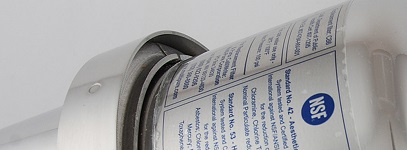
It's Not Just the ChlorineFriday, June 3, 2016 - by Water2Drink
With the nation’s attention focused on the ongoing lead
poisoning of Flint, Michigan’s drinking water, you may be re-examining your own
local water source and the ways in which your municipality disinfects it. Many cities, towns, and smaller water associations may use
chorine as a primary disinfectant. But recently, the use of chloramines as a
secondary disinfectant has increased since chloramines can help reduce the
regrowth of microorganisms during the transport of water between the treatment
plant and consumers. However, there is an increasing cause for concern
regarding the use of chloramines in addition to chlorine as a disinfection
agent.
A recent article on the Water Technology website states
that, “Inorganic chloramines are increasingly chosen as secondary disinfectant
treatments for drinking water in municipal water systems because they are less
chemically reactive than free #chlorine. They produce fewer disinfection
byproducts than chlorine, and they survive longer during drinking water
distribution to consumers.” The article
by Dr. Joseph Cotruvo, Technical Editor and former director of the EPA Drinking
Water Standards Division, goes on to say that updated Environmental Protection
Agency regulations regarding total trihalomethanes (TTHM), “tightened
compliance computation requirement in 2006. All of these [updated regulations] increased
the numbers of water systems likely to be out of compliance with TTHMs or HAAs
and led many to change to the chloramine approach.”
Do you wonder why Water2Drink worries about chloramines, and
why you should too? As with chlorine, the disinfection qualities of #chloramines
can be quite beneficial, right up until the point of ingesting them in your
water. Chloramines are harmful to kidneys and can negatively affect kidney
dialysis patients. Swimming pools, enclosed fountains, and other indoor treated
water sources will release chloramines, which must then be vented properly so
as to avoid respiratory irritation. This too can negatively affect citizens
with asthma and other respiratory illness.
And in addition, the use of chloramines results in changes
to the treated water chemistry which in turn disintegrates old #lead water
lines, releasing lead into the treated water as it travels into your home or
business. That is exactly what happened in #Flint.
There is a highly effective way to protect yourself and your
loved ones. Install a point-of-use, solid carbon block Multipure Drinking Water
System! A Multipure Drinking Water System will become the final barrier to the
increasing hazards of municipally treated water. Water2Drink.com exclusively
sells the Multipure family of Drinking Water Systems which are NSF-tested and
certified to reduce not only chlorine, but also chloramines to NSF/ANSI
Standard 42 (>98.3% reduction), and TTHMs to NSF/ANSI Standard 53 (>99.8%
reduction). Multipure Drinking Water Systems also reduce lead, mercury, radon, and
a multitude of other contaminants. Contact
Water2Drink.com today and let us help you make the best selection of a Multipure
Drinking Water System for your family.
|
|
Tweet
|
Leave a Comment


 Comments
Comments